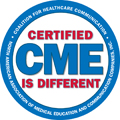Good, old-fashioned continuing medical education (CME)—the kind produced by accredited providers—has lost its cachet. Once the medical-education flagship, it has been subsumed in a sea of other types of activities: online and off-, self-directed and live, promotional and non-biased. The result is that “CME” has become a catchall to denote all manner of med ed.
Two groups, out to change what they see as overuse of the term, are launching a cooperative effort to underscore the difference between certain CME activities and others.
“Certified CME,” a phrase whose use they encourage, is distinguished from other kinds of educational activities. It’s the kind for which attendees can earn credit hours from an organization that ensures learner needs are met and that content is scientifically rigorous, objective, balanced and independent, according to information the groups released.
This effort puts a “stake in the ground that says all CME activities are not alike,” said Marty Cearnal, co-chair of the CME committee of the Coalition for Healthcare Communication, one of the organizers. Also involved is the North American Association of Medical Education and Communication Companies (NAAMECC).
NAAMECC and the Coalition produced a business-card-size handout with a definition and a bright blue button that reads, “Certified CME is different.” Both will be distributed at the annual American Medical Association (AMA) meeting of the National Task Force on CME Provider-Industry Collaboration, which starts tomorrow in Arlington, VA, and at the Alliance for CME (ACME) meeting in January.
Their goal is to establish the difference in the halls of Congress and among regulators, physicians and even casual observers. Much of the recent criticism of CME has often been “sweeping, but the fact is that most of the concerns don’t really apply to certified CME activities,” Cearnal said.
He explained that “CME” has become a generic term, applied accurately to a range of activities that physicians and other healthcare professionals get involved with as they keep updated and strive to improve patient care.
For instance, two kinds of med ed that are often referred to as CME include physician-directed learning, which does qualify as CME, and promotional activities, which do not.
“This is not to say that [one] is any more or less valid or important than the others,” Cearnal said. “[But] if you put it all together into a stew, it’s difficult for people to understand the discussion.”
Certified CME is not a new term. It refers to the kind created by a provider accredited by the ACCME, AOA or the AAFP—the three main organizations empowered to certify a physician educational activity. Confusion arises when terms are misused, such as when referring to a “certified provider” (providers are not certified; activities are). In another instance of incorrect parlance, the Senate Finance Committee in its April report on the use of educational grants cited “accredited educational programs.”
Said Cearnal: “If we continue to use this broad, generic term, then CME gets lumped together with all other CE activities, and that does create the opportunity for a misunderstanding that just doesn’t need to be there.”
He said the two groups hope to reinforce additional definitions going forward. Their effort may help regulators examining medical education, maybe even some members of Congress, understand the nuances.








